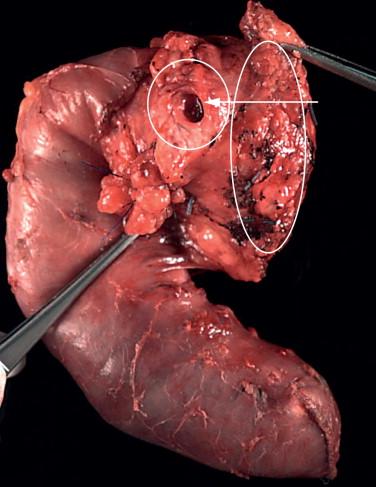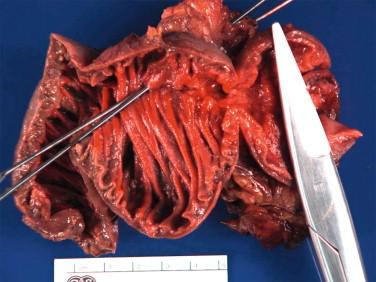Physical Address
304 North Cardinal St.
Dorchester Center, MA 02124
Intraoperative/frozen section consultations on pancreaticobiliary surgeries are mainly performed for the assessment of resection margins of the specimens and to rule out the possibility of metastatic disease at sites such as liver, peritoneum, omentum, mesentery, and lymph nodes. Only rarely a core biopsy of the pancreas is received for frozen section to help make the intraoperative diagnosis of a mass lesion because most often the surgeons have the preoperative radiographic and/or pathologic diagnosis or they have committed to a certain surgical procedure which is not altered by frozen section analysis. Table 13-1 lists the indications for frozen section on pancreaticobiliary specimens. Table 13-2 summarizes the work flow related to pancreaticobiliary intraoperative consultations.
|
|
|
|
|
|
|
|
|
| Work Flow |
|
|
|
|
|
For an ampullectomy specimen, usually performed for ampullary adenoma, a frozen section may be requested for the evaluation of margins and for any evidence of invasive carcinoma.
The resection margins vary depending upon the type of specimen ( Table 13-3 ). Proper orientation of the specimen is a key to accurate frozen section assessment of the margins.
| Type of Surgery | Type of Margin | Sectioning of Margin |
|---|---|---|
| Whipple resection |
|
|
|
|
|
|
|
|
| Central pancreatectomy |
|
|
| Distal pancreatectomy |
|
|
| Enucleation |
|
|
| Ampullectomy |
|
|
|
|
|
|
|
|
|
|
The resection margins for the Whipple specimen on which frozen section is requested are pancreatic body/neck resection margin, bile duct resection margin, and uncinate/retroperitoneal margin. Depending upon the location of the tumor (ampullary, pancreas, or bile duct), the surgeon may elect to freeze one or all of the three margins.
The specimen can usually be oriented as follows: the longer segment of the resected bowel is the distal aspect of the specimen; the pancreatic uncinate process margin, often rough and cauterized, is located at the inferior-posterior aspect of the head of the pancreas; and the pancreatic body/neck resection margin is at the distal end of the pancreatic specimen, which is identified by appreciating the cut surface of the pancreatic parenchyma with pancreatic duct in the center ( Figure 13-1 ). The bile duct is present between the pancreatic body/neck resection margin and the proximal portion of the bowel. The ampulla can be probed to identify both bile duct and pancreatic resection margin ( Figure 13-2 ). For complex specimens, the surgeons should be encouraged to designate the margins with suture. This is especially true in cases in which vascular structures are removed en bloc with the specimen because these are often difficult to appreciate unless clearly indicated. Frozen section is usually not requested for the uncinate margin because the surgeons quite often cannot remove any more of the pancreatic tissue in this area even if the margin is positive. In addition, positivity along the uncinate is generally considered a poor prognostic sign, and adding additional risk by trying to extend this margin surgically is unlikely to be useful. In rare cases where the consistency of the tissue along the uncinate margin is fibrotic or otherwise atypical, such as in a patient that has received neoadjuvant chemoradiation, there may be utility to frozen section to see if wider resection should be performed. Since the uncinate margin consists of a large surface area, it is best to perform the frozen section at the most suspicious area marked by the surgeon.


The pancreatic resection margin may be difficult to identify in severe chronic pancreatitis when the normal lobularity of the pancreas is lost due to marked atrophy and fibrosis. Uncinate margin can be confused as the pancreatic resection margin when a small portion of the pancreatic head is removed. It can be difficult to identify the bile duct resection margin when a short segment of bile duct is removed, the duct is retracted, or when it is stapled or tied with a purse-string suture. Occasionally, a dilated pancreatic duct in an atrophic pancreas can resemble the bile duct resection margin. In these circumstances, it is imperative that the specimen is oriented with the surgeon’s assistance.
The distal pancreatectomy specimen will generally be provided as an isolated portion of pancreas either with or without an attached spleen. Variable amounts of omentum or nodal tissue may be adherent. Commonly proximal margin is requested for frozen section. If a spleen-preserving approach has been utilized, there may be a separate distal staple line or suture line where vascular structures along the tip of the pancreas are divided. In these cases, the distal pancreas is an important margin, and analysis may be requested intraoperatively. Critical to this process (unless the spleen is attached) is that suture or some other marker is placed to orient distal and proximal aspect of the specimen. Attached tissue such as stomach or colon should be indicated also with suture, but intraoperative assessment is rarely required.
Central segmental pancreatic resection is a relatively uncommon procedure which involves removal of the mid-pancreas with reattachment of the distal pancreatic remnant back to stomach or intestine. As such, all segmental resection specimens must be accurately oriented by the surgical team (preferably with suture) to indicate proximal and distal margins and anterior or posterior aspects.
Become a Clinical Tree membership for Full access and enjoy Unlimited articles
If you are a member. Log in here